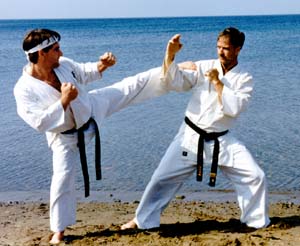
Links:
DK's Domain
Martial Arts Info Home
Lesson Synopsis:
2/5/09
We will start this tutorial with some basic lessons. It is important to learn the basics in a more professional manner with a teacher properly versed in the martial arts. These are just a few basics to keep in mind. These are the foundations of all the major schools of organized fighting.
Photos to help explain the lesson shall be added at a later date.
Stretching
The need to stretch your body cannot be over stated as this increases both agility, flexibility, and speed of movement, while decreasing the potential of cramping, overstretching, or ripping of muscles. It also helps reduce the soreness of muscles after a good exercise. The most important parts of the body to stretch are the back, the legs, arms, neck, and chest. The back can be stretched by bending your back downwards while keeping your legs straight. This also stretches the legs. By standing straight and expanding your chest outwards while putting arms to the side so they form a 'V' shape with your body stretches out your back, chest, and arms. The chest and arms can be further stretched by standing straight, and moving arms back and forth across chest from extremes similar to how a bird would flap its wings. The legs can be stretched by stretching the muscles behind the knee by standing straight and bending over while straightening one leg to its maximum possible for you (careful that your muscles do not start pulsating or else your muscles can tear. Your legs should form a right triangle with the ground, with your other leg being slightly bent to allow full stretching of leg being stretched. The arms can be stretched by simply pulling them both behind your back and holding for a few seconds with your hands straight and your chest outward while your back is straight. The neck can be stretched by moving it in all possible movements while your body is straight, especially in circular motions clockwise and counterclockwise.
Posture and Balance
Posture is very important for all fighters. Those who have excellent posture usually end up at a significant advantage over their opponents. It not only makes them harder to throw and adds strength to their punches, but it also prevents them from being knocked off balance easier. Posture and balance are related. Balance allows one to have a significant advantage over his opponent in all realms of combat. Posture is also necessary for overall good health and self-esteem. The best way to straighten your posture is to practice straightening your back against a straight wall by putting your feet, lower back, shoulders, and head against the wall. A healthy curvature of the back in necessary for further building the power to unleash deadly blows. It is important to keep your head rested straight and level on your shoulders. Slouching is a martial artist's greatest adversary. Never ever slouch. It causes great problems for future health and makes a person significantly weaker. Another tip for good posture is to sleep on one's back or to sleep on the sides, but never to sleep on the stomach. Walking properly is also another way in which posture can be improved. Good shoes with proper soles help to support a person's weight. Shoes manufactured by Nike, Reebok, and other sports companies for basketball, running, and sports help maintain good posture. These shoes must be warn often to prevent complications for the feet and back. More tips on improving posture shall be discussed later. Concerning balance, the more one evenly distributes their full body weight on both feet the more balanced they are. Weight should only be shifted when moving in for an attack, and this only to reposition one's balance closer to an enemy, thus pushing them off balance. The general rule is the closer one is to the ground, the more balance one has. Bending knees comfortably while standing straight can help prevent someone from knocking you off balance. Balance is central to maintaining superiority in a fight. If one's balance is kept strong while the enemy loses balance, there is no reason why he should ever lose a fight.
Fighting Stances
The most simple fighting stance is the street-fighting stance which can be observed by boxers, kickboxers, martial artists, and street fighters. This stance allows quick punches and great movement. One side, usually the right, is facing the enemy and the body is turned so that it is hard to hit the chest, face, and stomach area. Most of the punches and kicks will hit the arm, side of body, and the leg facing the opponent. You can also actively switch to the other side, in this case the left side. The arm facing the opponent is used for quick, light jabs, while the arm in the back is used to swing larger, stronger punches with stepping and switching the stance position. The back leg should step forward with the back arm which is punching so that this will now become the one facing the enemy. This makes your blows stronger. Punching will be discussed later. In this stance, it is important to always keep your hands up so that any possible attacks to the face or head can be blocked. However, you do not want your hands to cover your eyesight, just to be ready to block attacks. The hands should also be kept in fists so they are ready to punch the enemy.
Blocking
The next important lesson, even before punching, is learning to block attacks.
Punching
Kicks
Grabbing
Submission Holds
